| Index - September, 2019 |
|
Editorials
|
On These Shoulders We Stand
by Suzanne Gillis
Proudly and sadly we say good-bye to Vermont Woman, for this is the last issue. Letting go is tough. Anytime a newspaper closes, the community it served loses.
As a niche publication specifically for Vermont women, this loss is bound to be felt deeply by those of us who have contributed to it, and by you, the Vermont Woman readers. We hope you are as proud as we are that Vermont Woman ends as the longest running women’s advocacy newspaper of its kind in the nation. Continue Reading...
A Paper of Our Own
by Kate Mueller
I met Rickey Gard Diamond, Vermont Woman’s founding editor, and her then future husband, Stephen MacArthur, at Goddard College in 1980, when we were all enrolled in the adult degree program. We were there at very different points in our lives. Continue Reading...
Vermont Woman—Feisty, Creative, Passionate, Independent
by Margaret Michniewicz
Around this time eight years ago we were in the midst of production of my final issue as editor of Vermont Woman when Hurricane Irene struck Vermont—a natural disaster no one predicted occurring in the Green Mountain State. Continue Reading...
|
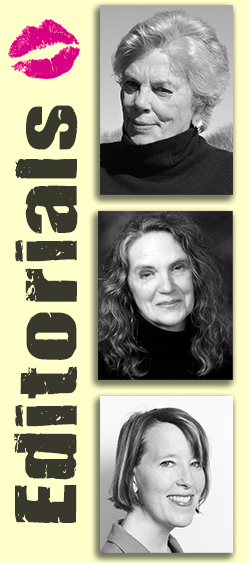 |
|
VERMONT WOMAN—Spanning 34 Years, 1985 to 2019
|
When a community loses a newspaper, a little bit of its soul goes with it.
A good paper serves to connect its readers, to provide a public forum for different opinions, to profile as many community members as possible, and to provide a venue for businesses to reach the best market for their goods and services. A newspaper’s editorial content should inform, inspire, and educate, bringing public awareness to issues of concern and highlighting achievements. And from time to time, a good paper should agitate and infuriate.
As a women’s advocacy publication, Vermont Woman published Vermont women’s points of view on issues ranging from the arts, aging, business, education, and the environment to finance, health, politics, relationships, and sports. We set out to bring women’s opinions and voices shedding transparency on every male-dominated institution, shining a glaring light on the inequities suffered by women.
We did not cover fashion, diets, or hairdos. And we rarely included men’s viewpoints, as they were already massively covered in the dominant male-owned and -staffed media, locally, regionally, and nationwide. We wanted to be provocative and take on some tough topics, such as the politics of breast cancer prevention, women and AIDS, domestic violence in Vermont, the trans community, women in prison, and incest survivors—while, at the same time, spotlighting women’s challenges, achievements, and breakthroughs.
Continue Reading...
|
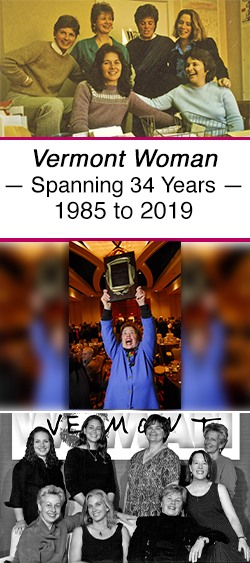 |
|
Vermont Woman Speaker Series Brought the Community Together to Be Inspired & Informed
|
From 2004 to 2009, Vermont Woman produced and hosted a lecture series called Vermont Woman Newspaper Annual Speaker Series. The intent was to bring speakers to the region in an effort to inform the community on issues of local, state, and global importance. To that end, Vermont Woman invited outstanding women in politics, government, and the media. Gloria Steinem, legendary feminist, and Helen Thomas, longtime member of the White House press corps, came twice to Vermont to speak.
Other lecturers included Jehan Sadat, widow of Egypt’s Anwar Sedat; Texas governor Ann Richards; news commentator Eleanor Clift; and outed CIA agent Valerie Plame Wilson. Held at both the Sheraton Hotel and the Hilton in Burlington, these events drew up to a thousand attendees, who eagerly listened and asked questions. The lectures often included book signings, as many of the speakers were also authors.
Continue Reading...
|
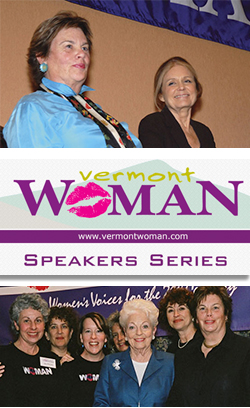 |
|
Women's Rights — Where Do We Go from Here?
by Cary Brown |
Who hasn’t looked back on their past and thought about how things might have gone if they only knew then what they know now? It’s a question that inevitably leads to other, tougher questions. Have I come as far as I thought I would? What about my entire generation? What have we done to make the world a better place than it was when we arrived?
In my high school yearbook, I stated my ambition: “To reform the world.” I wanted to fix things, to make things the way they were supposed to be, because I was so sure that things should be fair, equitable, peaceful, smart, and compassionate.
I was a teenager and came of age in the ’80s—right around the time Vermont Woman newspaper was born. As a teenager, many things enraged me. My sense of justice (and injustice) was highly personal, but I could also see how it extended beyond the individual and into the social. I had many thoughts and opinions about how the world needed to be reformed.
At some point in my childhood I realized that the default human being was, in everyone’s view, apparently male—females were extra add-ons, not the regular kind of person but some variant. This fed a swiftly growing sense of outrage and injustice that fueled my interest in politics and my engagement in social justice. Not to mention my engagement in hours of heated debates with boys in my high school classes. (Another peek into my senior yearbook: I was awarded “class arguer.")
Continue Reading...
|
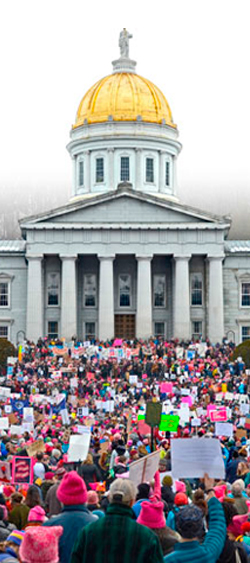
|
|
Ten Vermont Women of Achievement Then and Now
by Cynthia Close
|
In November 1985, Sue Gillis launched Vermont Woman, with Rickey Gard Diamond as founding editor. At that time, the paper carried a subtitle: “For Vermont Women of Achievement,” chosen by Gillis. Diamond said she expressed her concern to Gillis that the publication would only focus on the traditional version of success: well-coiffed upper-middle-class women in business suits, valuing only money and status. But no, Gillis also believed that achievement meant a great deal more than that, and so “we titled our first cover ‘Women: Redefining Achievement,’” said Diamond. In remembering that decision-making process, she said, “We found [achievement] meant different things to different women, and so the cover includes a woman farmer and an athlete and a mom with her family and a teacher, an artist, and more than one activist—women of many shapes, sizes, colors, and ages, including our first female governor. It still makes me smile when I look at it.”
The 15 women of the original editorial board generated the idea of many photos on the cover and came up with suggestions for categories and particular women, with Gillis and Diamond making the final determination of who would be honored as women of achievement. By casting a wide net, they were able to present well-known women like Madeleine Kunin from the political arena alongside Ellen Smith, an administrative assistant with the Abenaki Self-Help Association. The cover communicated to the potential Vermont Woman audience that the publication would practice inclusivity and that all women would be valued for the kind of work they did, whether it be in business, sports, the arts, education, politics, or the home.
Continue Reading...
|
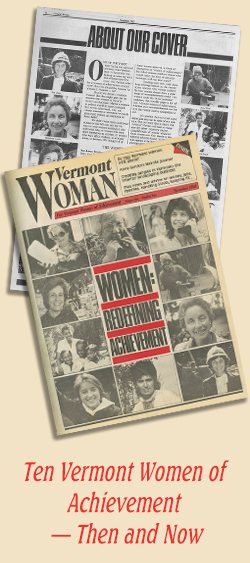 |
|
Five Women at Work, with Passion & Commitment
by Diane DeBella
|
In a head nod to Vermont Woman’s first issue, which featured an eclectic group of 10 women, we interviewed five Vermont women who have made outstanding contributions in a wide variety of fields: Thea Alvin, stonemason; Mari Cordes, state legislator; Katrina Ducharme, state trooper; Peggy Luhrs, activist; and Linda Schadler, scientist. These five women talk about how they chose their paths in life and what keeps them going, what keeps the passion alive.
Thea Alvin: Stonemason, Sculptor, Teacher
When a fire becomes hot enough, even stone will crack. A stone structure, once solid and resilient, can collapse into a heap of dust. Internationally acclaimed stonemason and sculptor Thea Alvin, 51, knows firsthand the devastation of fire. In December of 2017, she was enjoying the creative community of artists who had come to live with her and her partner, sculptor Michael Clookey, at their home in Morristown. They shared meals together and focused on creating their art, which they displayed and sold in the Rock, Paper, Scissors Gallery on the property.
All that changed when a fire destroyed the barn, gallery, and part of the main house a day before the winter solstice. A beloved herd of goats and most of the chickens perished, as did countless antiques and much of Alvin and her husband’s life work. Anyone experiencing such trauma, loss, and grief would be tempted to collapse into a heap of dust. Yet Alvin woke the next day and put one foot in front of the other—steadfast, strong, and resilient.
Continue Reading...
|
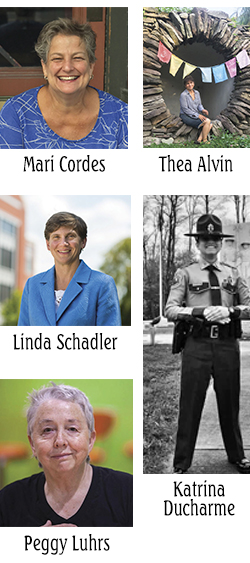
|
|
A Short History of the Lesbian Feminist Origins of Gay Liberation in Vermont
by Peggy Luhrs
|
It was 1972 and I was living in Burlington with my friend Sally and her daughter. I had just broken up with my husband, and we were sharing custody of our son, Justin. Two single moms living together meant we could take turns with the kids, enabling us each to go to the Fresh Ground Coffee House, which in 1972 was meeting central for Burlington feminists and leftists. At the organizing meeting for the first Vermont Women’s Conference in 1972, I met and befriended George, one of the few lesbians I knew then. She invited me to come over to her Old North End apartment the next day.
No sooner was I in the door when she held up a small magazine, “Look at this.” It was a copy of Amazon Quarterly, the first literary magazine with a lesbian perspective, started that very year. Wow! AQ with its amazing and iconic cover image of an Amazon on horseback. I’d never seen pictures of these spear-wielding women. My generation grew up with Leave It to Beaver and Father Knows Best. It is hard to convey how startling and exciting this image was to me at that moment, one that stays with me still.
Coming Out
I began my first lesbian relationship and a lesbian rap group—rap as in talk freely and frankly—on the same night in March 1973. My friend and soon-to-be-lover Faye Speed and I organized the first lesbian rap group. It was a success. Nine women showed up at my St. Paul Street apartment. We could talk about being lesbians, what that meant, and how we would navigate our new path. Having overcome the greatest obstacle, coming out to ourselves, we delighted in one another’s company and support.
Continue Reading...
|

Counterclockwise from the bottom: Michiyo Fukaya, Peggy Luhrs, Mavis Smith, Kris Drum, and Deanne Brittingham, attending the first lesbian gay pride parade and celebration, City Hall Park, Burlington, June 1983.
photo: Lynn Vera
|
|
What Would an Economy of Our Own Look Like?
by Rickey Gard Diamond |
I’m not an economist; I don’t even play one on TV. I’m a writer, an educator, and a business owner who, like most, has learned economics the hard way. Yet I’m bothered that most women’s eyes glaze over whenever I talk about the UN’s National Accounts and the GDP, monetary policy and the Federal Reserve, or something called public banking. What, they seem to be thinking, could be more boring?
In 2008, we found out just how exciting economics can be. Over two and a half million US jobs disappeared, and a third of US real estate value flew out the window. It took a decade for the US median household income to pass what it had been in 2008, now at $60,336. Meanwhile prices have gone up and threaten to go higher with Washington’s trade war.
Over the past 35 years, so-called free market changes in the rules of our money system and tax policies have reliably moved dollars up to those already with a surplus. If you haven’t enough savings to pay for a college degree, a car to get you to your job, or a house, you must borrow. Businesses and governments borrow too. With interest reliably doubling debt, the upward movement of our system’s pyramid scheme hoists dollars up to the unneedy. This is aided by Wall Street bro-bloviation, and sometimes corruption.
Continue Reading...
|
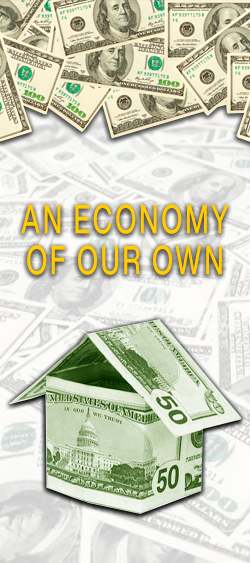 |
|
|

